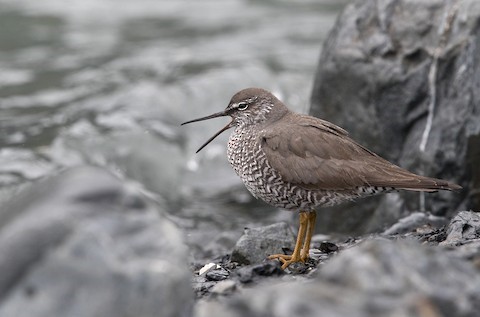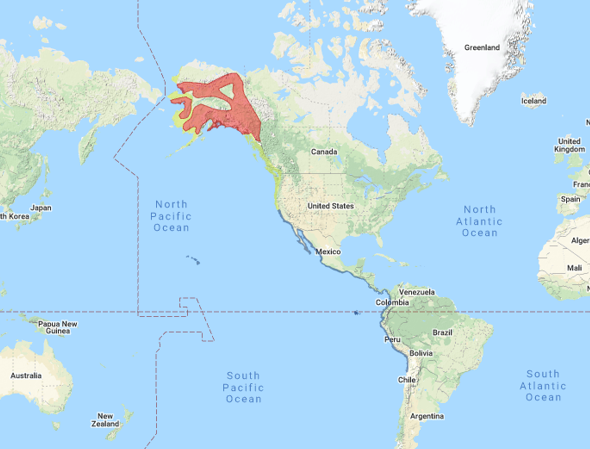Birdfinding.info ⇒ Widespread but thinly distributed across much of the Pacific region. From September to April nonbreeders occur along the coasts of California and Baja California on jetties and breakwaters constructed of rip-rap. In Hawaii, it can be found on all the main islands along lava-dominated shorelines and around coastal lagoons such as Kealia Pond on Maui and Aimakapa Pond on the Big Island. In Australia, small numbers winter on islands of the Great Barrier Reef and along the main coast south to Sydney—e.g., annual at Flat Rock in Ballina, New South Wales.
Wandering Tattler
Tringa incana
Breeds in Alaska and adjacent areas. Winters on Pacific islands and coasts.
Breeding. Breeds from late May to July in mountainous areas of Alaska, the Yukon, northern British Columbia, and at least occasionally in eastern Chukotka. Nests in creekbeds and other gravelly terrain.
Nonbreeding. Winters on rocky shores, reefs, and other shoreline habitats, along the Pacific coastline of the Americas from California to Peru, and on most Pacific island groups, including Hawaii, the Galápagos, and generally throughout Polynesia.
Smaller numbers winter westward across Micronesia and Melanesia to Palau, New Guinea, and eastern Australia, occasionally south to New Zealand.
A few stragglers—presumably first-year birds—remain on the wintering grounds year-round.
Movements. Northbound migration apparently begins in late March or early April as South Pacific birds move into the northern tropics. However, most movement occurs in May as nonstop transoceanic flights across the North Pacific.
Southbound migration begins in late July. Some adults depart the breeding grounds earlier and some juveniles linger later, but they are largely synchronized and often travel south together. Arrivals on wintering grounds occur from August to October.
Vagrants have occurred in the interior of North America, east to the Great Lakes, New York, and Texas, and west to Japan and Taiwan.
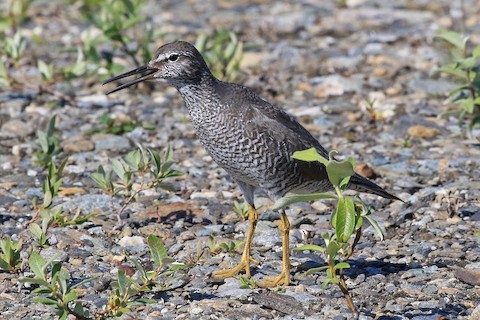
Wandering Tattler, on breeding territory. (Nome, Alaska; June 21, 2016.) © Phillip Edwards
Identification
A stocky, mid-sized, mostly gray sandpiper with short yellow legs and a straight bill, strongly associated with rocky shores. Habitually teeters and bobs like an Actitis sandpiper.
Very similar to the closely related Gray-tailed Tattler, and can be nearly identical, but somewhat darker and slightly larger (for a detailed comparison, see below).
In all adult plumages, the upperparts appear uniformly gray. Has a thick, blackish lore-stripe and a whitish supraloral—both of which extend more faintly behind the eye.

Wandering Tattler, breeding plumage. (La Jolla, California; May 16, 2017.) © Jeff Maw

Wandering Tattler, breeding plumage. (Seward, Alaska; June 4, 2016.) © Lars Petersson

Wandering Tattler, breeding plumage, with accentuated black lore. (Passage Island, British Columbia; August 12, 2020.) © Ken Wright
Breeding adults are heavily marked with a wavy pattern of gray and white barring on the underparts. The gray markings are densest on the breast and sparsest on the mid- and lower belly, which can be all-white.

Wandering Tattler, breeding plumage. (Pescadero, California; August 5, 2018.) © Matt Davis
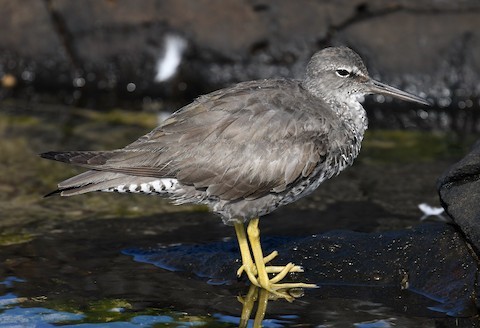
Wandering Tattler, breeding plumage. (Flat Rock, Ballina, New South Wales, Australia; October 2, 2018.) © Steven McBride
The crown is solid-gray, but the face and neck are finely streaked with white.
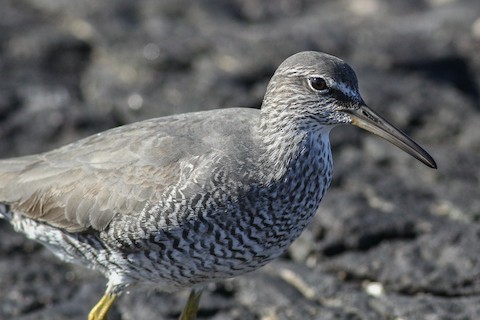
Wandering Tattler, breeding plumage. (Flat Rock, Ballina, New South Wales, Australia; April 9, 2017.) © Andrew Naumann
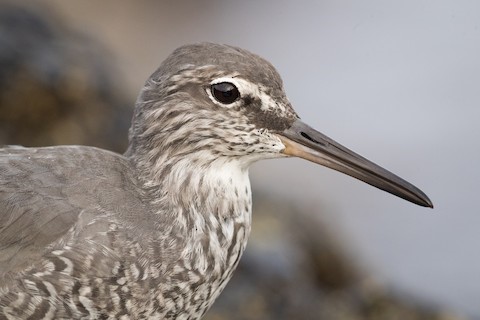
Wandering Tattler, breeding plumage. (La Perouse Bay, Maui, Hawaii; March 31, 2018.) © Ryan Sanderson
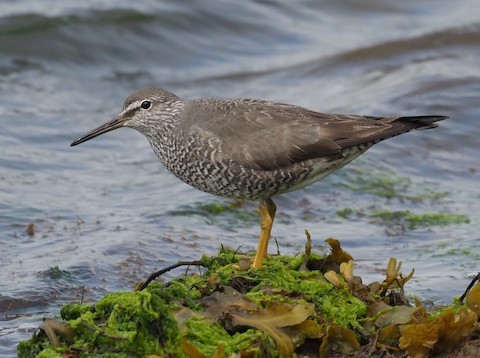
Wandering Tattler, breeding plumage. (St. Paul Island, Alaska; July 28, 2019.) © Stephan Lorenz
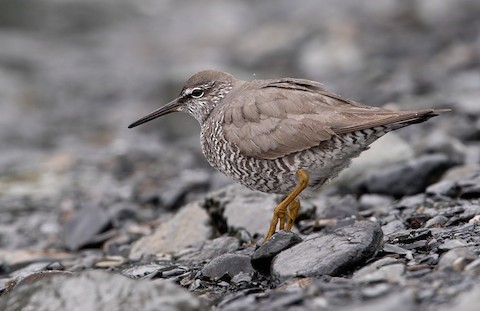
Wandering Tattler, breeding plumage, showing barred flanks and undertail coverts. (Seward, Alaska; June 4, 2016.) © Lars Petersson
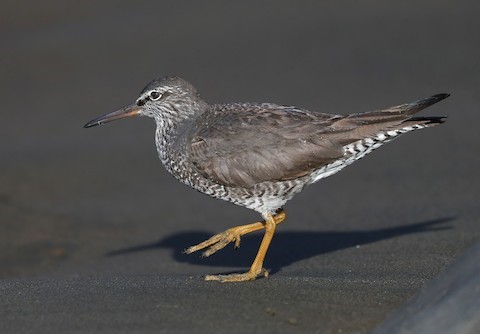
Wandering Tattler, breeding plumage, showing barred flanks and undertail coverts. (Drakes Beach, Point Reyes, California; May 25, 2019.) © Matt Davis

Wandering Tattler, molting into breeding plumage. (Scripps Institute, La Jolla, California; March 29, 2014.) © Alison Davies
Nonbreeding adults also have gray and white underparts, but unmarked. The chest and flanks are mostly gray and the belly and throat are mostly white.
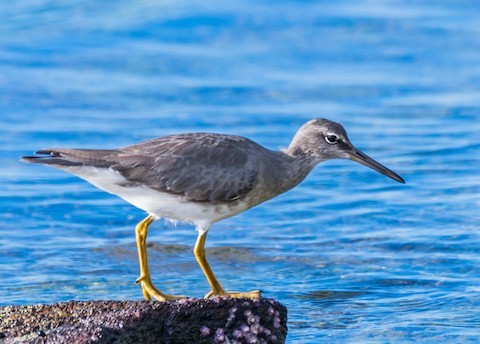
Wandering Tattler, nonbreeding plumage. (Aimakapa Pond, Kaloko-Honokohau National Historical Park, Big Island, Hawaii; January 1, 2020.) © Jim Merritt
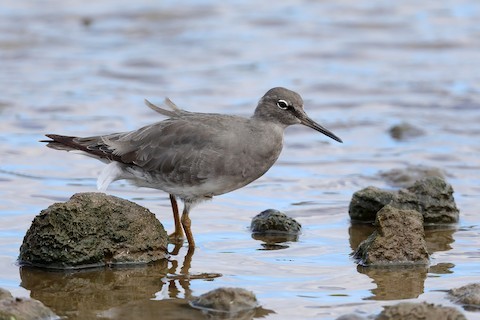
Wandering Tattler, nonbreeding plumage. (Kealia Pond National Wildlife Refuge, Maui, Hawaii; October 18, 2019.) © Doug Hommert
The facial markings on nonbreeding adults are often indistinct.

Wandering Tattler, nonbreeding plumage. (Kealia Pond National Wildlife Refuge, Maui, Hawaii; February 20, 2020.) © Stefan Mutchnick

Wandering Tattler, nonbreeding plumage. (Scripps Institute, La Jolla, California; January 21, 2016.) © Ilya Povalyaev
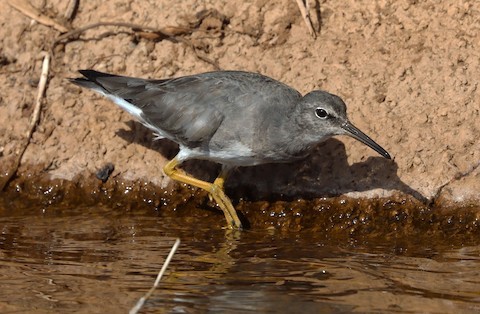
Wandering Tattler, nonbreeding plumage. (Kealia Pond National Wildlife Refuge, Maui, Hawaii; February 20, 2020.) © Stefan Mutchnick

Wandering Tattler, nonbreeding plumage. (Na Pali Coast State Park, Kauai, Hawaii; March 19, 2018.) © Russ Morgan
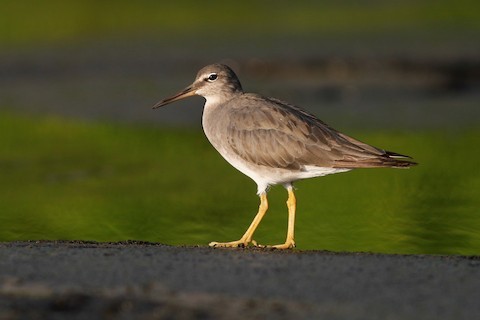
Wandering Tattler, nonbreeding plumage. (Aimakapa Pond, Kaloko-Honokohau National Historic Park, Big Island, Hawaii; October 26, 2019.) © John Sullivan
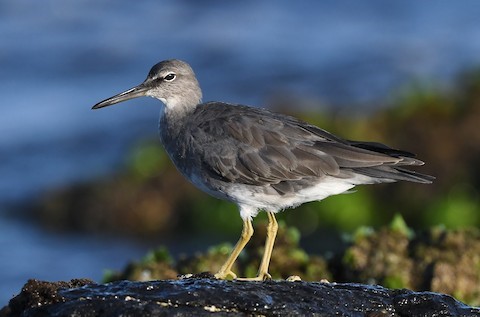
Wandering Tattler, nonbreeding plumage. (Flat Rock, Ballina, New South Wales, Australia; January 31, 2020.) © Steven McBride

Wandering Tattler, nonbreeding plumage. (Amalau Lookout, American Samoa National Park, American Samoa; November 5, 2017.) © Eric VanderWerf

Wandering Tattler, nonbreeding plumage. (Morro Bay, California; October 26, 2019.) © Tom Edell
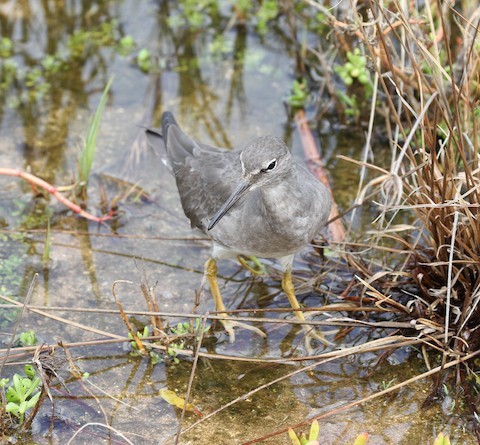
Wandering Tattler, nonbreeding plumage. (Kealia Pond National Wildlife Refuge, Maui, Hawaii; February 7, 2020.) © Dan Brooke

Wandering Tattler, nonbreeding plumage. (Lady Elliot Island, Queensland, Australia; December 12, 2020.) © Richard Fuller
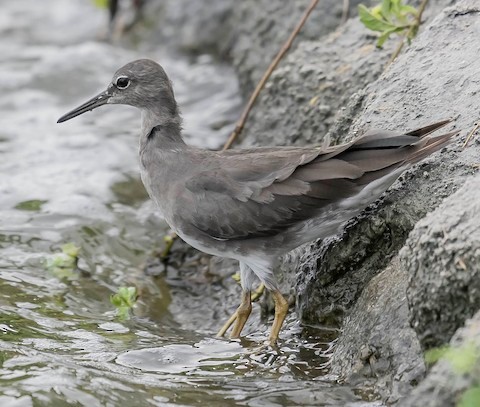
Wandering Tattler, nonbreeding plumage. (Aimakapa Pond, Kaloko-Honokohau National Historical Park, Big Island, Hawaii; December 6, 2019.) © William Richards
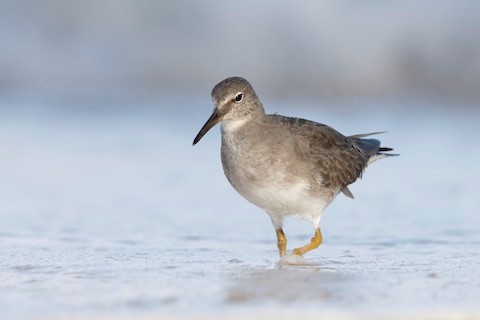
Wandering Tattler, nonbreeding plumage. (Malaekahana State Recreation Area, Oahu, Hawaii; January 26, 2019.) © Sharif Uddin
Juveniles resemble nonbreeding adults, but have narrow whitish fringes that create a scaled pattern on the upperparts and flanks.
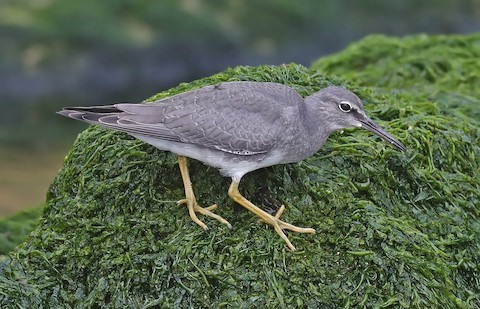
Wandering Tattler, juvenile. (Pescadero, California; August 5, 2018.) © Matt Davis
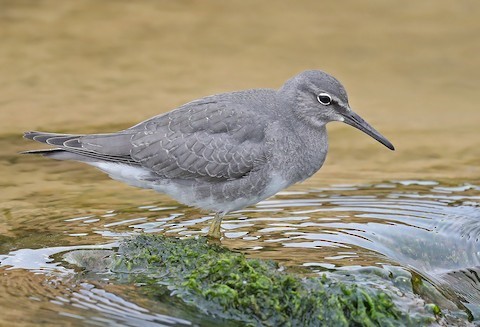
Wandering Tattler, juvenile. (Pescadero, California; August 5, 2018.) © Matt Davis
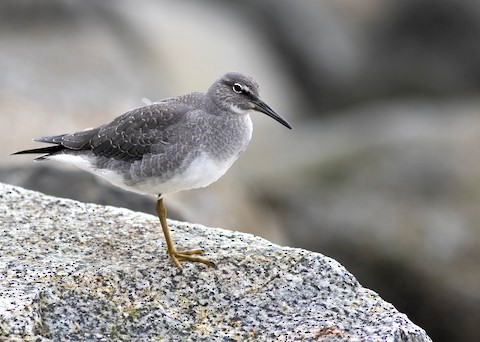
Wandering Tattler, juvenile. (Iona Island, British Columbia; August 28, 2016.) © Logan Lalonde

Wandering Tattler, juvenile, appearing unusually pale. (Barview, Oregon; September 24, 2019.) © Tanner Martin
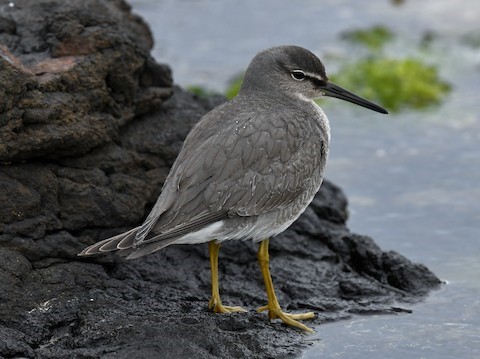
Wandering Tattler, juvenile. (Flat Rock, Ballina, New South Wales, Australia; October 5, 2019.) © Steven McBride

Wandering Tattler, juvenile. (Sandy Point, Neptune Beach, Washington; August 21, 2017.) © Eric Ellingson

Wandering Tattler, juvenile. (Florence, Oregon; August 12, 2019.) © Jonathan Eckerson

Wandering Tattler, juvenile. (Iona Island, British Columbia; August 31, 2014.) © Ilya Povalyaev

Wandering Tattler, juvenile. (Newport, Oregon; August 9, 2017.) © Isaac Denzer

Wandering Tattler, juvenile. (Flat Rock, Ballina, New South Wales, Australia; October 5, 2019.) © Steven McBride
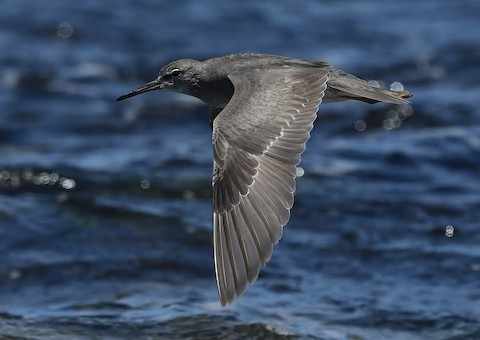
Wandering Tattler, juvenile. (Flat Rock, Ballina, New South Wales, Australia; December 4, 2020.) © Steven McBride

Wandering Tattler, juvenile. (Flat Rock, Ballina, New South Wales, Australia; December 4, 2020.) © Steven McBride
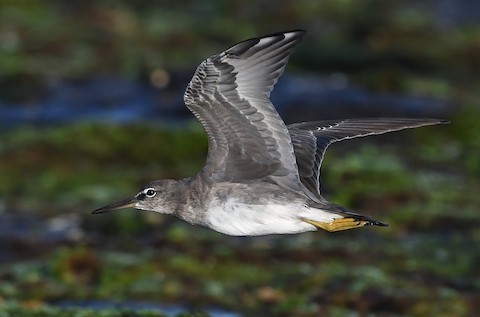
Wandering Tattler. (Flat Rock, Ballina, New South Wales, Australia; January 31, 2020.) © Steven McBride
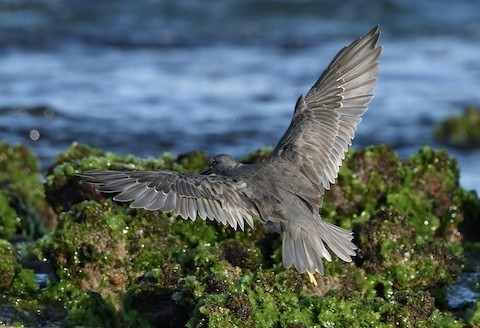
Wandering Tattler. (Flat Rock, Ballina, New South Wales, Australia; January 31, 2020.) © Steven McBride
Cf. Gray-tailed Tattler. Wandering and Gray-tailed Tattlers are nearly identical sibling species which occur together regularly across much of the western and central Pacific from Beringia south through Micronesia and Melanesia to Australia and New Zealand. Wandering is darker overall and more heavily marked in breeding plumage, but there is a broad zone of overlap in which many individuals, especially nonbreeding adults, are ambiguous—nondescript, plain-gray sandpipers (see comparison below).
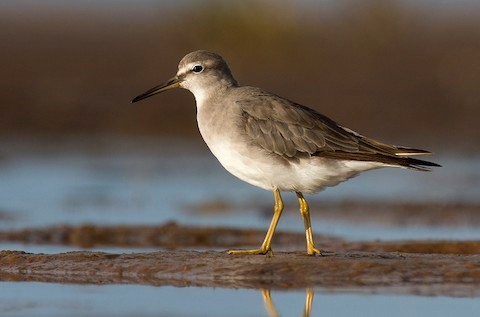
Gray-tailed Tattler, nonbreeding plumage. (Carnarvon, Western Australia; November 7, 2015.) © Leslie George

Wandering Tattler, nonbreeding plumage. (Aimakapa Pond, Kaloko-Honokohau National Historic Park, Big Island, Hawaii; October 26, 2019.) © John Sullivan
Fortunately, breeding adults and juveniles are somewhat more distinctive.

Gray-tailed Tattler, breeding plumage. (Kawasaki, Kanagawa, Honshu, Japan; May 23, 2018.) Anonymous eBirder

Wandering Tattler, breeding plumage. (St. Paul Island, Alaska; July 28, 2019.) © Stephan Lorenz
Depending on the circumstances of an observation, potentially useful distinctions include: voice; habitat; general coloration; facial markings; barring on the underparts; and typical juvenile plumages. Despite the name, tail color is rarely a useful clue.
Voice: Vocalizations are the most reliable means of identifying an ambiguous tattler, though they are more variable and can be more similar than most references imply.
Wandering’s common calls are trills or slower series of high-pitched notes—usually monotone or in a narrow range. However, on the breeding grounds, Wandering’s trills are more variable, less monotone, sometimes structured in distinct phrases, which it may repeat rhythmically.
Gray-tailed has two common call types: trills and upslurred, two-syllable whistles (tuu-WEET!). Its trills can resemble Wandering’s, but are usually more fluid and variable in pitch. Gray-tailed sometimes blends these call-types, repeating its typical whistle as a trill.
Habitat: The tattlers have somewhat different preferences. Wandering prefers rocky shores and reefs, whereas Gray-tailed prefers mudflats and sandy beaches. Habitat is not a reliable indicator—as each occurs in the other’s favored settings—but it can be a helpful clue.
General Coloration: Both tattlers are predominantly gray, but they differ in shade. Wandering averages darker, roughly medium-gray, whereas Gray-tailed usually seems pale-gray, sometimes appearing bleached. These are subjective impressions, and rarely definitive, but helpful as a first impression and in combination with other factors.
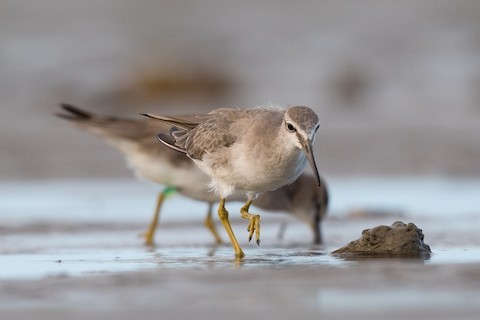
Gray-tailed Tattler, a nonbreeding-plumaged individual with brows that clearly meet on the forehead, as is typical of Gray-tailed. (Queens Esplanade, Thorneside, Queensland, Australia; December 19, 2020.) © Terence Alexander
Facial Markings: Across all plumages, the most consistent visual difference between that tattlers is that Gray-tailed’s eyebrow is consistently longer and wider than Wandering’s. This is not an absolute distinction, but it is a strong tendency, despite the variation within each species which leads to some overlap and a few ambiguous individuals.
Some references indicate that Gray-tailed’s brows always meet on the forehead, whereas Wandering always has at least a thin gray divider on its forehead. In general, Gray-tailed has much more white on its forehead (sometimes extending onto the forecrown in streaks) and its brow tends to be much wider than Wandering’s. But both species vary: some Wandering have relatively bold brows which can meet (or nearly meet) on the forehead, and some Gray-tailed have atypically short, indistinct brows that appear to be divided on the forehead.

Wandering Tattler, juvenile showing dark forehead and divided brows typical of Wandering. (Flat Rock, Ballina, New South Wales, Australia; October 5, 2019.) © Steven McBride

Wandering Tattler, a nonbreeding-plumaged individual with wide brows that appear to meet—or nearly so—on the forehead, thus resembling Gray-tailed Tattler. (Malaekahana State Recreation Area, Oahu, Hawaii; January 26, 2019.) © Sharif Uddin

Gray-tailed Tattler, a nonbreeding-plumaged individual with brows that appear divided—or nearly so—on the forehead, thus resembling Wandering Tattler. (Queens Esplanade, Thorneside, Queensland, Australia; November 30, 2019.) © Hayley Alexander
Barring on the Underparts in Breeding Plumage: Breeding adults are identifiable by the density and extent of gray bars or chevrons on the underparts. On Wandering in peak breeding plumage, the gray bars are thicker, denser, and more extensive compared to Gray-tailed, which has relatively narrow and sparse markings.
In particular, Gray-tailed is essentially all-white on the lower breast and belly, and has at most a few isolated bars on the undertail coverts, whereas Wandering in breeding plumage has several bold bars on the undertail.
However, adult tattlers spend much of the year in between peak breeding plumage and typical nonbreeding plumage. In their intermediate stages the two species overlap, so a lightly-marked Wandering can look much like a Gray-tailed—which means, in effect, that all Gray-tailed look like a lightly-marked Wandering. Some differences in pattern may be consistent, but they are difficult to generalize.

Gray-tailed Tattler, breeding plumage, showing mostly unmarked flanks, as is typical of Gray-tailed. (Bukhta Narva, Primorskiy Kray, Russia; May 21, 2019.) © Pavel Parkhaev

Wandering Tattler, breeding plumage, showing barred flanks and undertail coverts, diagnostic for Wandering. (Drakes Beach, Point Reyes, California; May 25, 2019.) © Matt Davis
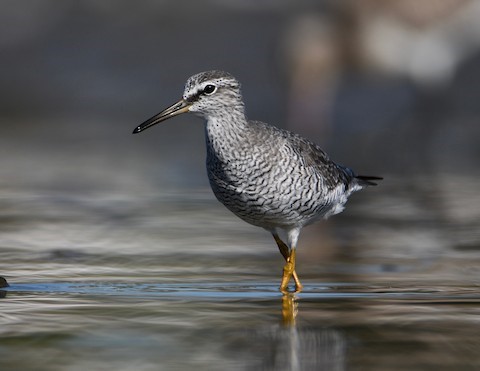
Gray-tailed Tattler, breeding plumage—at the dark and heavily marked end of the spectrum, and thus easily confused with Wandering, but note the wide, long eyebrow and white streaks on the forehead. (Queens Esplanade, Thorneside, Redland, Queensland, Australia; April 3, 2020.) © Michael Daley
Juvenile Patterns: In fresh juvenile plumage, Wandering has whitish edges on the upperparts, giving it a scaly appearance, whereas juvenile Gray-tailed has a “toothed” pattern: dotted lines that consist of whitish spots separated by dark spots. These patterns can be distinct, and in such cases they appear to be reliable, but they fade with feather-wear and become unreliable.

Gray-tailed Tattler, juvenile showing prominent toothed or dotted-line pattern on upperparts. (Gambell, St. Lawrence Island, Alaska; September 3, 2019.) © Tammy McQuade

Wandering Tattler, juvenile showing faint scaled pattern on upperparts and flanks. (Flat Rock, Ballina, New South Wales, Australia; October 5, 2019.) © Steven McBride
Confusingly, some juvenile Wandering Tattlers show a toothed pattern—not as strong as a typical fresh juvenile Gray-tailed, but similar enough to be ambiguous. Adding to the potential confusion, some nonbreeding adult Gray-tailed have a slight scaled pattern—similar to juvenile Wandering.
The underparts also differ: juvenile Gray-tailed is white on the belly and flanks, whereas juvenile Wandering has more extensive gray, including the flanks—often with whitish edges, creating a scaled appearance, as on the upperparts.

Wandering Tattler, juvenile, appearing unusually pale—and showing a faint dotted-line pattern—but gray, faintly scaled flanks indicate Wandering, not Gray-tailed. (Barview, Oregon; September 24, 2019.) © Tanner Martin
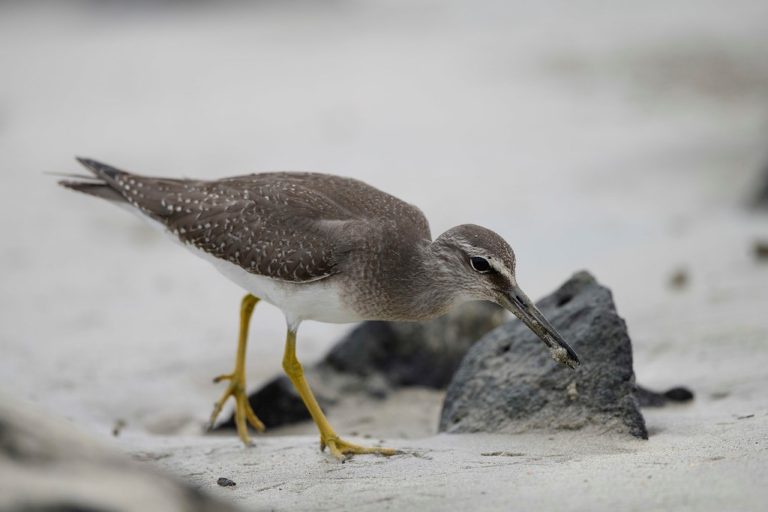
Gray-tailed Tattler, juvenile, appearing unusually dark for a Gray-tailed, but showing prominent toothed or dotted-line pattern on upperparts and bold eyebrow. (Taiwan; October 11, 2020.) © Sin Syue Li
Tail Pattern: The name “Gray-tailed” is misleading, as both tattlers have gray tails. The difference is that adult Wandering’s tail is solid-gray, unmarked, whereas adult Gray-tailed has a subtle pale-scaled pattern on the uppertail coverts and rump. Unfortunately, this pattern is rarely discernible, and it appears to be useless for juveniles, as both species begin with a scaled appearance on the tail.

Wandering Tattler, juvenile showing plain, unmarked gray tail. (Flat Rock, Ballina, New South Wales, Australia; December 4, 2020.) © Steven McBride

Gray-tailed Tattler, nonbreeding plumage, showing very subtle scaled pattern on uppertail coverts. (Nairns, Mandurah, Western Australia; November 29, 2017.) © Geoffrey Groom
Academic Distinctions: A few of the differences often cited in references are unhelpful in field identification. Wandering averages about 5% larger than Gray-tailed in most measurements, but they overlap, so the potential size difference is both subtle and inconsistent. Their bills have a depression or groove that includes the nostril—the “nasal groove”—which reputedly exceeds half the bill length on Wandering, but not on Gray-tailed. However, some photographs of Wandering appear to have shorter grooves, so this supposedly absolute distinction may be misleading.
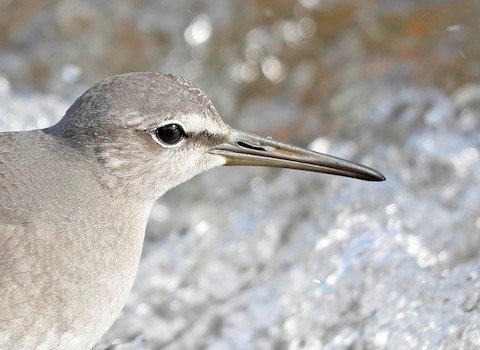
Gray-tailed Tattler, juvenile, close-up showing nasal groove ending near the mid-point of the bill. (Gambell, St. Lawrence Island, Alaska; September 3, 2019.) © Tammy McQuade
Notes
Monotypic species. The two tattlers, Wandering and Gray-tailed (brevipes), were traditionally assigned to their own genus, Heteroscelus.
References
Alderfer, J., and J.L. Dunn. 2014. National Geographic Complete Birds of North America (Second Edition). National Geographic Society, Washington, D.C.
BirdLife International. 2016. Tringa incana. The IUCN Red List of Threatened Species 2016: e.T22693305A93395464. https://dx.doi.org/10.2305/IUCN.UK.2016-3.RLTS.T22693305A93395464.en. (Accessed April 9, 2021.)
Brazil, M. 2009. Birds of East Asia. Princeton University Press.
eBird. 2021. eBird: An online database of bird distribution and abundance. Cornell Lab of Ornithology, Ithaca, N.Y. http://www.ebird.org. (Accessed April 9, 2021.)
Howell, S.N.G., I. Lewington, and W. Russell. 2014. Rare Birds of North America. Princeton University Press.
Howell, S.N.G., and S. Webb. 1995. A Guide to the Birds of Mexico and Northern Central America. Oxford University Press.
Marchant, J., T. Prater, and P. Hayman. 1986. Shorebirds: An Identification Guide to the Waders of the World. Houghton Mifflin, Boston.
Pratt, H.D., P.L. Bruner, and D.G. Berrett. 1987. A Field Guide to the Birds of Hawaii and the Tropical Pacific. Princeton University Press.
Pyle, R.L., and P. Pyle. 2017. The Birds of the Hawaiian Islands: Occurrence, History, Distribution, and Status. Version 2 (January 1, 2017). http://hbs.bishopmuseum.org/birds/rlp-monograph/. B.P. Bishop Museum, Honolulu, Hawaii.
Schulenberg, T.S., D.F. Stotz, D.F. Lane, J.P. O’Neill, and T.A. Parker. 2007. Birds of Peru. Princeton University Press.
Sibley, D.A. 2000. The Sibley Guide to Birds. Alfred A. Knopf. New York.
Xeno-Canto. 2021. Wandering Tattler – Tringa incana. https://www.xeno-canto.org/species/Tringa-incana. (Accessed April 9, 2021.)
